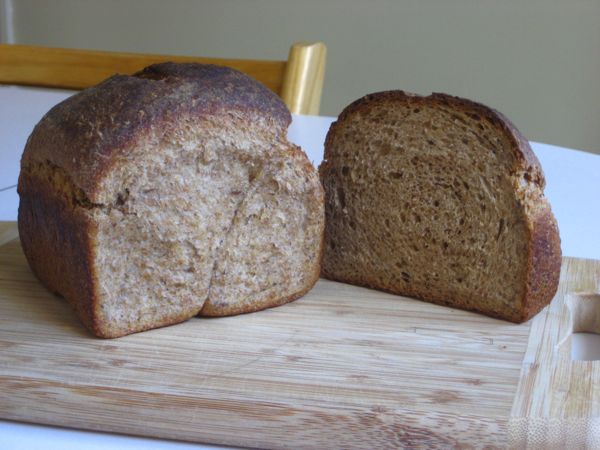This is a variation on Joe Ortiz' recipe in The Village Baker (as indeed so many of my breads are).
Basically I've sourdoughed it up, and subbed in hot cereal for rye meal.
Evening of Day 0
Mix 1 cup rye flour with 3/4 cup warm water, and a tablespoon or so of active liquid starter ("sufficient" starter).
In a separate bowl, mix 1 cup Bob's Red Mill 7-Grain Cereal with 1 cup boiling water. This cereal is a multi-grain cracked-grain cereal (like steel cut oats or Irish oats, NOT rolled), and I think any such cereal would behave very similarly.
Let these stand overnight. By morning the rye sponge should be very active. I'm not too fussy about "ripeness" but you may want to wait until it starts to fall (indicating ripeness).
Morning of Day 1
- 1-2 tablespoons of raisins (to taste)
- 1-2 teaspoons caraway seed (to taste)
- 3 tablespoons quite warm water
Joe suggests that you combine these with a mortar and pestle into a paste. I don't have this tool, so I chop the raisins and caraway together on a cutting board (the raisins, properly used to surround and cover the caraway, prevent the chopped seeds from flying all over the place) as fine as I have the patience for. Either way, let soak for a little while. A few minutes is fine. An hour is fine.
Combine the two bowls from the previous night, the raisin-caraway mixture, and 2 teaspoons of salt.
Mix in about 2 cups bread flour (you'll have to work some in kneading, probably). You're looking for a firm dough here. 55% hydration, maybe? Joe says 'a medium dough'. I think of it as an American style dough.
Knead 5-10 minutes. The cereal and the rye flour seem to make the dough completely un-windowpane-able, so knead until feels right, or for 10 minutes if you don't feel like you have a sense of what "feels right" is!
Bulk rise for a couple of hours, it may not double, but eventually it will have inflated substantially, and a poke test will indicate "done" (use a wetted finger to poke a hole 1/3 of an inch deep, if the hole fills back in VERY SLOWLY or not at all, you're probably there). Oil up a loaf pan sufficient to hold all the dough. Mine is a standard loaf pan, but "largish" rather than "smallish". It might be 9-10 inches long, and 4 inches wide?
Divide dough in two, flatten each piece. For each piece:
- Fold the far 1/3 toward you, flatten with heel of hand.
- Fold the bottom 1/3 away from you, so it overlap the previous fold, flatten.
- Fold the right 1/3 in just as you did the top, flatten.
- Left 1/3 to overlap the previous fold, flatten.
You can repeat this a few times -- you're giving the dough more strength, if it's not "fighting" you a bit, give it a couple more turns. You should have a neat rectangular packet at this point. Make your last two folds:
- More gentle, more of a "rolling up" than a flattening out.
- So that the length of the final packet is about 1/2 the length of your loaf pan -- the fold will go ALONG the length of the pan, not across. Imagine two jelly-rolls end-to-end in the pan.
Repeat for the other half of the dough. You SHOULD have, assuming my instructions are clear enough, two sort of rolled up lumps which when you place them end to end will pretty much fit neatly in your oiled loaf pan.
Oil the ends of each roll of dough, the ends that will press against one another in the pan, in the middle, and plop them into the pan. This will form an easily pulled-apart seam in the middle.
Let rise in the pan, again it may not double but will inflate and start "poke" testing right. DO NOT PREHEAT THE OVEN.
When it's risen, brush a little oil on the top of each half of the loaf, and slash each half lengthwise down the middle. Place in cold oven, and turn the temperature to 450. Bake for 25 minutes, turn down to 400 and bake another 40-45 minutes. The loaves will be very dark brown.
One of the reasons I love this recipe so is that I don't have to preheat the oven, which is great because I am absent-minded, AND I save energy!
The bread is mild-rye-ish, a little sweet from raisins (depending on how many you used) and a little caraway flavored (again, depending on how much you put in) and has a mild sour tang. The crumb is moist and dense, and has little crunchy bits in it from the hot cereal, which we like for texture.
This shows the "middle" end of one of the two mini-loaves, where the two press together, and get peeled apart:

And this shows the other end, the end up against the end of the metal loaf pan:

Finally, crumb:
